Human Resource Management Report: Recruitment, Benefits, and Practices
VerifiedAdded on 2020/06/05
|15
|4491
|3001
Report
AI Summary
This report provides a detailed analysis of Human Resource Management (HRM), examining its purpose, functions, and various practices within an organizational context. It begins with an introduction to HRM, highlighting its significance in directing employee actions and achieving organizational objectives. The report then delves into the purpose and functions of HRM, including recruitment, selection, employee relations, orientation, training, and development. It evaluates the strengths and weaknesses of internal and external recruitment approaches. The benefits of HRM practices for both employers and employees are explored, emphasizing policy development, guidance, conflict resolution, and employee development. The report also assesses the effectiveness of HRM practices in terms of profitability, productivity, and employee satisfaction. Furthermore, it underscores the importance of employee relations in influencing HRM decision-making, including elements of employment legislation and its impact on these decisions. The report concludes with applications of HRM practices in an organizational context, providing valuable insights for effective human resource management. The report uses Marks and Spencer (M&S) as a case study.
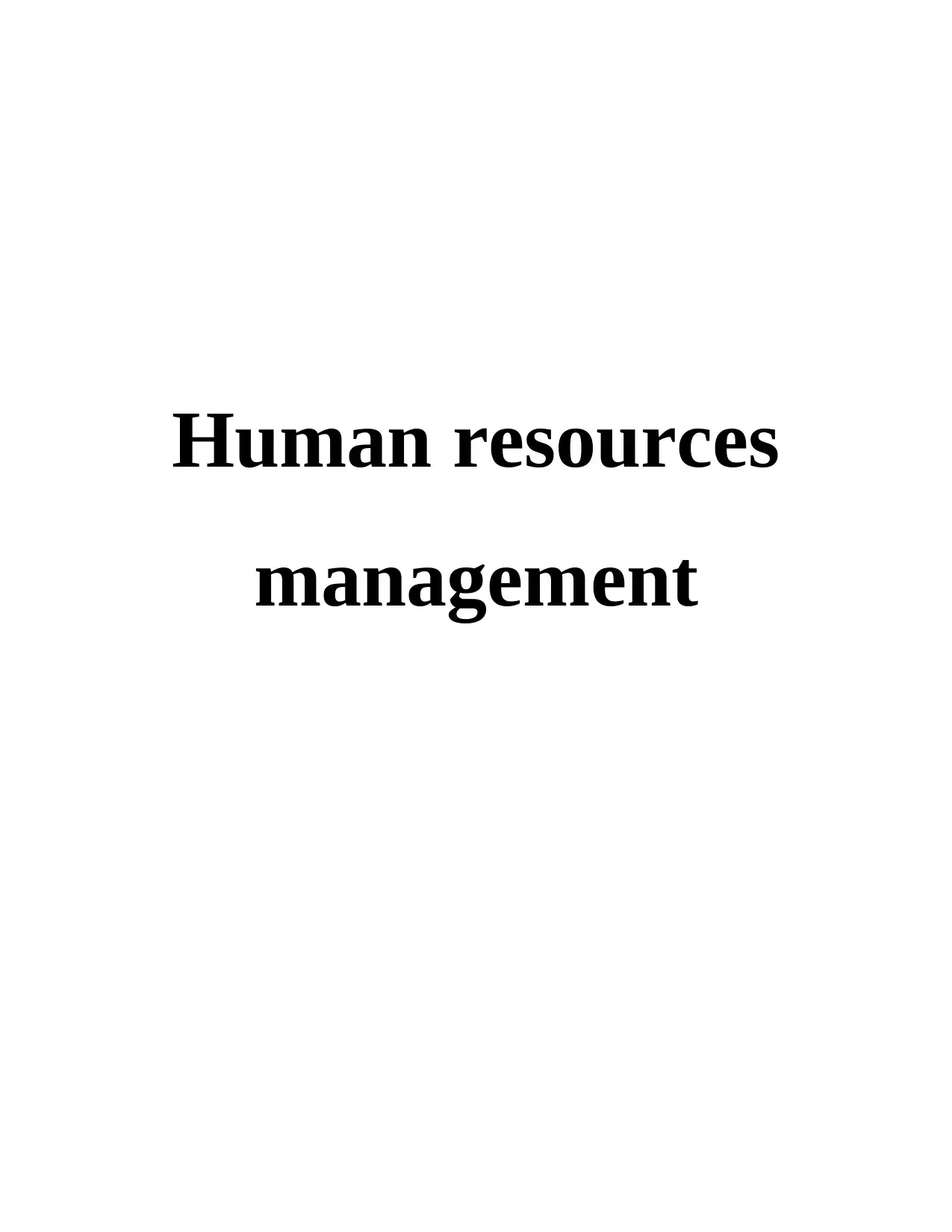
Human resources
management
management
Paraphrase This Document
Need a fresh take? Get an instant paraphrase of this document with our AI Paraphraser
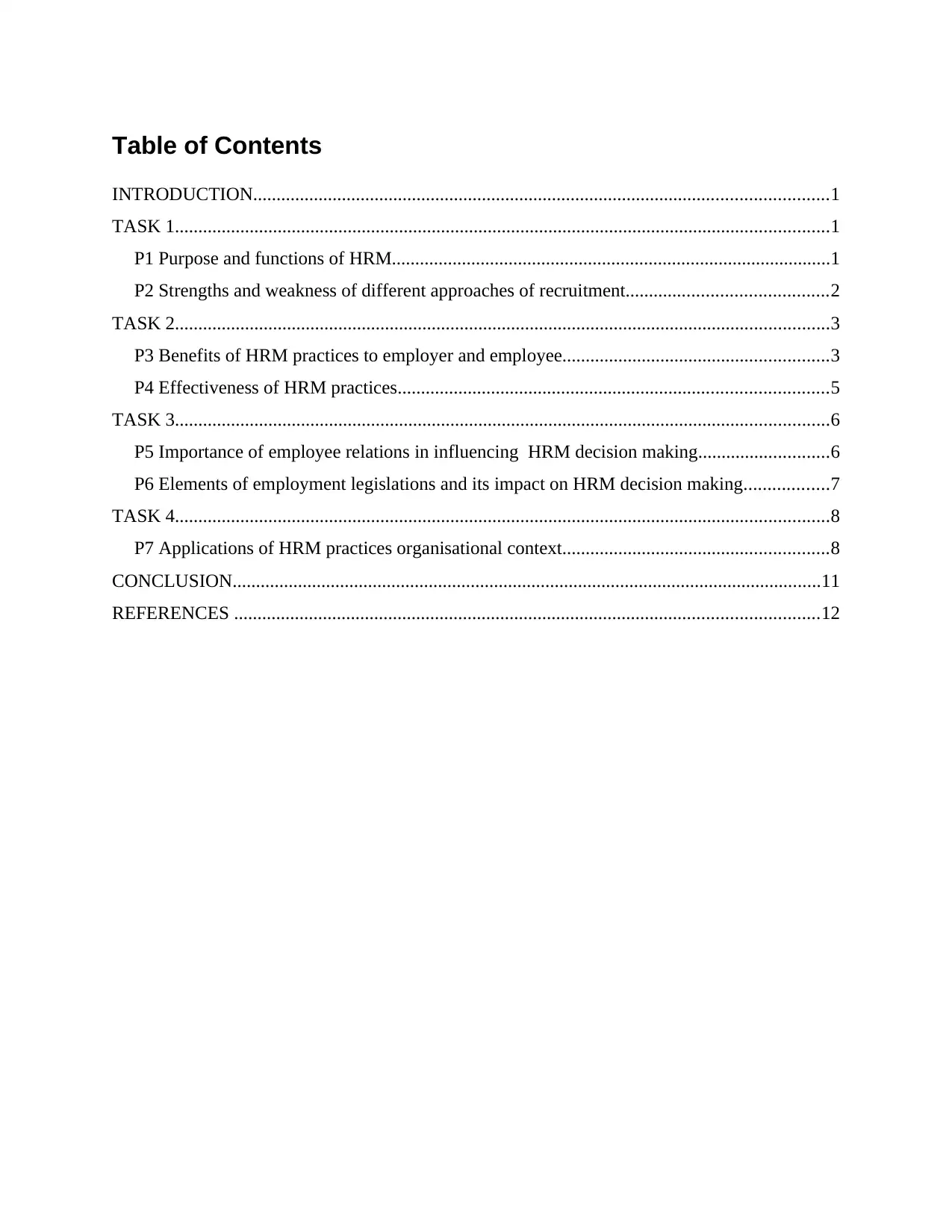
Table of Contents
INTRODUCTION...........................................................................................................................1
TASK 1............................................................................................................................................1
P1 Purpose and functions of HRM..............................................................................................1
P2 Strengths and weakness of different approaches of recruitment...........................................2
TASK 2............................................................................................................................................3
P3 Benefits of HRM practices to employer and employee.........................................................3
P4 Effectiveness of HRM practices............................................................................................5
TASK 3............................................................................................................................................6
P5 Importance of employee relations in influencing HRM decision making............................6
P6 Elements of employment legislations and its impact on HRM decision making..................7
TASK 4............................................................................................................................................8
P7 Applications of HRM practices organisational context.........................................................8
CONCLUSION..............................................................................................................................11
REFERENCES .............................................................................................................................12
INTRODUCTION...........................................................................................................................1
TASK 1............................................................................................................................................1
P1 Purpose and functions of HRM..............................................................................................1
P2 Strengths and weakness of different approaches of recruitment...........................................2
TASK 2............................................................................................................................................3
P3 Benefits of HRM practices to employer and employee.........................................................3
P4 Effectiveness of HRM practices............................................................................................5
TASK 3............................................................................................................................................6
P5 Importance of employee relations in influencing HRM decision making............................6
P6 Elements of employment legislations and its impact on HRM decision making..................7
TASK 4............................................................................................................................................8
P7 Applications of HRM practices organisational context.........................................................8
CONCLUSION..............................................................................................................................11
REFERENCES .............................................................................................................................12
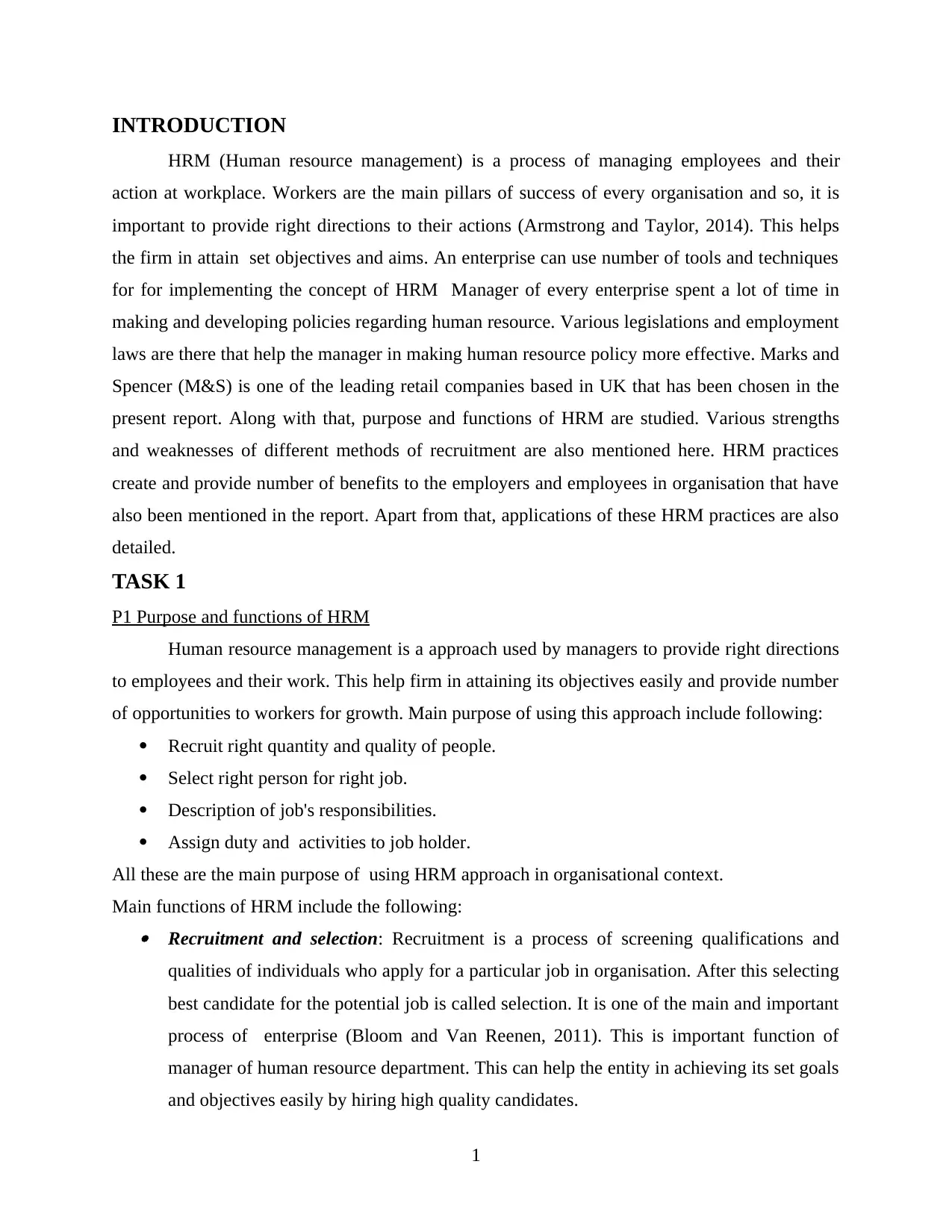
INTRODUCTION
HRM (Human resource management) is a process of managing employees and their
action at workplace. Workers are the main pillars of success of every organisation and so, it is
important to provide right directions to their actions (Armstrong and Taylor, 2014). This helps
the firm in attain set objectives and aims. An enterprise can use number of tools and techniques
for for implementing the concept of HRM Manager of every enterprise spent a lot of time in
making and developing policies regarding human resource. Various legislations and employment
laws are there that help the manager in making human resource policy more effective. Marks and
Spencer (M&S) is one of the leading retail companies based in UK that has been chosen in the
present report. Along with that, purpose and functions of HRM are studied. Various strengths
and weaknesses of different methods of recruitment are also mentioned here. HRM practices
create and provide number of benefits to the employers and employees in organisation that have
also been mentioned in the report. Apart from that, applications of these HRM practices are also
detailed.
TASK 1
P1 Purpose and functions of HRM
Human resource management is a approach used by managers to provide right directions
to employees and their work. This help firm in attaining its objectives easily and provide number
of opportunities to workers for growth. Main purpose of using this approach include following:
Recruit right quantity and quality of people.
Select right person for right job.
Description of job's responsibilities.
Assign duty and activities to job holder.
All these are the main purpose of using HRM approach in organisational context.
Main functions of HRM include the following: Recruitment and selection: Recruitment is a process of screening qualifications and
qualities of individuals who apply for a particular job in organisation. After this selecting
best candidate for the potential job is called selection. It is one of the main and important
process of enterprise (Bloom and Van Reenen, 2011). This is important function of
manager of human resource department. This can help the entity in achieving its set goals
and objectives easily by hiring high quality candidates.
1
HRM (Human resource management) is a process of managing employees and their
action at workplace. Workers are the main pillars of success of every organisation and so, it is
important to provide right directions to their actions (Armstrong and Taylor, 2014). This helps
the firm in attain set objectives and aims. An enterprise can use number of tools and techniques
for for implementing the concept of HRM Manager of every enterprise spent a lot of time in
making and developing policies regarding human resource. Various legislations and employment
laws are there that help the manager in making human resource policy more effective. Marks and
Spencer (M&S) is one of the leading retail companies based in UK that has been chosen in the
present report. Along with that, purpose and functions of HRM are studied. Various strengths
and weaknesses of different methods of recruitment are also mentioned here. HRM practices
create and provide number of benefits to the employers and employees in organisation that have
also been mentioned in the report. Apart from that, applications of these HRM practices are also
detailed.
TASK 1
P1 Purpose and functions of HRM
Human resource management is a approach used by managers to provide right directions
to employees and their work. This help firm in attaining its objectives easily and provide number
of opportunities to workers for growth. Main purpose of using this approach include following:
Recruit right quantity and quality of people.
Select right person for right job.
Description of job's responsibilities.
Assign duty and activities to job holder.
All these are the main purpose of using HRM approach in organisational context.
Main functions of HRM include the following: Recruitment and selection: Recruitment is a process of screening qualifications and
qualities of individuals who apply for a particular job in organisation. After this selecting
best candidate for the potential job is called selection. It is one of the main and important
process of enterprise (Bloom and Van Reenen, 2011). This is important function of
manager of human resource department. This can help the entity in achieving its set goals
and objectives easily by hiring high quality candidates.
1
⊘ This is a preview!⊘
Do you want full access?
Subscribe today to unlock all pages.

Trusted by 1+ million students worldwide

Managing employee relations: workers are the main ingredient of success of any
company and it is very important task of manager to maintenance healthy relations with
employees (Boxall and Purcell, 2011). This can be attained by providing good work
climate to them and by providing them opportunities for growth. This help enterprise in
getting commitment of employees and achieve success easily. Orientation: Orientation is a process which help new candidate in adjust and understand
about the policies enterprise. The main objective of this programme is to help employees
and give them information about how they can achieve long and short term goals in firm. Maintaining Good and healthy work environment: It is main duty or responsibility of
manager to provide good and healthy working conditions to employees. Good working
conditions motivate employees to perform and give their best to company. Various
programmes should be undertaken by employers for employees welfare this helps in
increasing satisfaction level of employees.
Training and development: It is one of the important function of human resource
management. Continuous training programmes should be conducted by enterprises to
help employees in learning new things and methods. Specially for new employees it is
very essential to provide them training about the current working method used by firm.
If performed well, all these functions can create good results for M&S. All these
functions help employees in developing their skills and qualities in organisational context. This
make workers more able and make them ready to face future completive environment.
P2 Strengths and weakness of different approaches of recruitment
Recruitment is a process of hiring right person for right job which is very necessary every
enterprise (Bratton and Gold2012). For this number of recruitment sources can be used by M&S.
Internal and external are main source of recruitment.
Internal sources of recruitment: Under this enterprise use internal employees or workers to fill
higher vacancies. By using this approach of recruitment M&S can be benefited from number of
advantages:
Saving in cost of training expenditure to new employees.
Fast decisions of recruitment
Motivate employees to perform their best
Brings strong loyalty of employees
2
company and it is very important task of manager to maintenance healthy relations with
employees (Boxall and Purcell, 2011). This can be attained by providing good work
climate to them and by providing them opportunities for growth. This help enterprise in
getting commitment of employees and achieve success easily. Orientation: Orientation is a process which help new candidate in adjust and understand
about the policies enterprise. The main objective of this programme is to help employees
and give them information about how they can achieve long and short term goals in firm. Maintaining Good and healthy work environment: It is main duty or responsibility of
manager to provide good and healthy working conditions to employees. Good working
conditions motivate employees to perform and give their best to company. Various
programmes should be undertaken by employers for employees welfare this helps in
increasing satisfaction level of employees.
Training and development: It is one of the important function of human resource
management. Continuous training programmes should be conducted by enterprises to
help employees in learning new things and methods. Specially for new employees it is
very essential to provide them training about the current working method used by firm.
If performed well, all these functions can create good results for M&S. All these
functions help employees in developing their skills and qualities in organisational context. This
make workers more able and make them ready to face future completive environment.
P2 Strengths and weakness of different approaches of recruitment
Recruitment is a process of hiring right person for right job which is very necessary every
enterprise (Bratton and Gold2012). For this number of recruitment sources can be used by M&S.
Internal and external are main source of recruitment.
Internal sources of recruitment: Under this enterprise use internal employees or workers to fill
higher vacancies. By using this approach of recruitment M&S can be benefited from number of
advantages:
Saving in cost of training expenditure to new employees.
Fast decisions of recruitment
Motivate employees to perform their best
Brings strong loyalty of employees
2
Paraphrase This Document
Need a fresh take? Get an instant paraphrase of this document with our AI Paraphraser
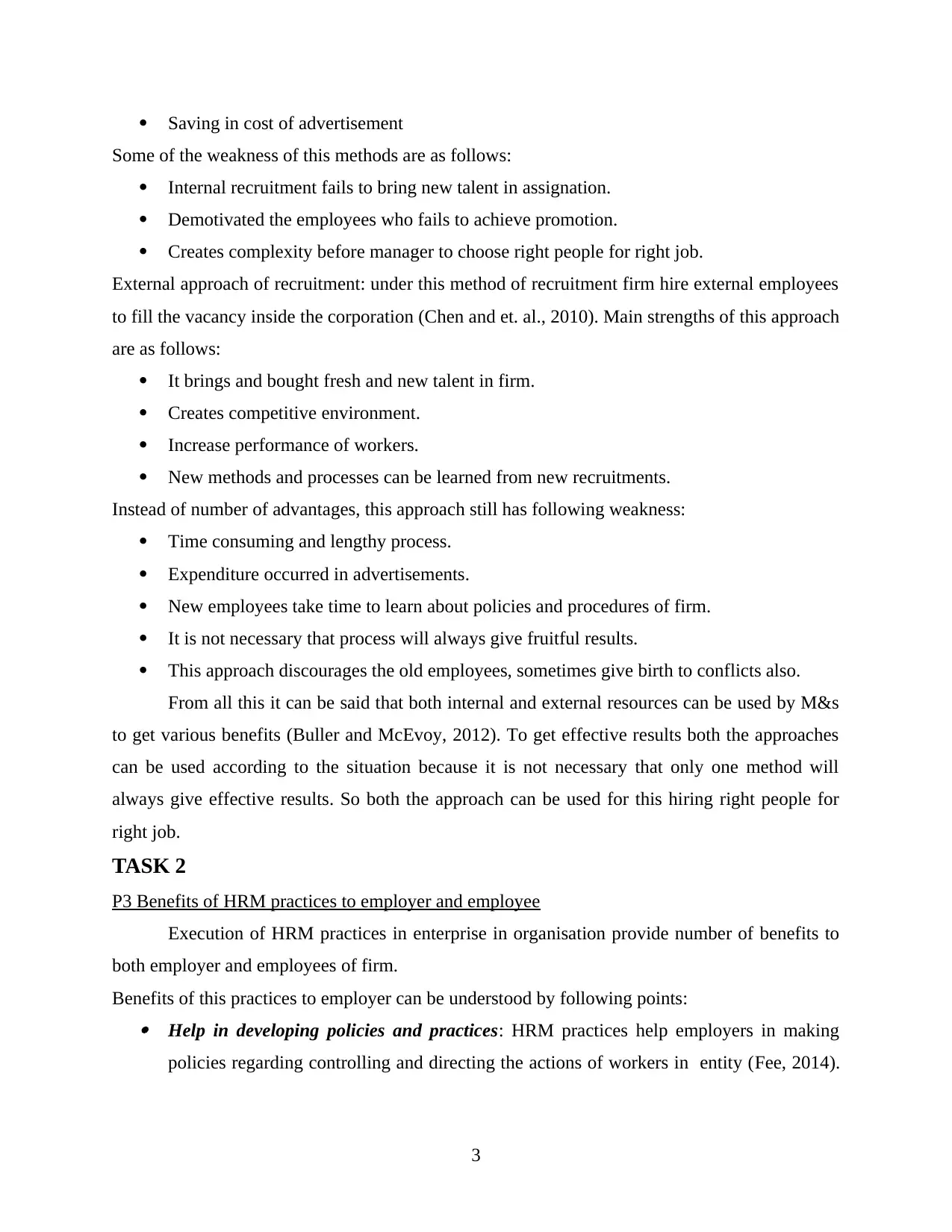
Saving in cost of advertisement
Some of the weakness of this methods are as follows:
Internal recruitment fails to bring new talent in assignation.
Demotivated the employees who fails to achieve promotion.
Creates complexity before manager to choose right people for right job.
External approach of recruitment: under this method of recruitment firm hire external employees
to fill the vacancy inside the corporation (Chen and et. al., 2010). Main strengths of this approach
are as follows:
It brings and bought fresh and new talent in firm.
Creates competitive environment.
Increase performance of workers.
New methods and processes can be learned from new recruitments.
Instead of number of advantages, this approach still has following weakness:
Time consuming and lengthy process.
Expenditure occurred in advertisements.
New employees take time to learn about policies and procedures of firm.
It is not necessary that process will always give fruitful results.
This approach discourages the old employees, sometimes give birth to conflicts also.
From all this it can be said that both internal and external resources can be used by M&s
to get various benefits (Buller and McEvoy, 2012). To get effective results both the approaches
can be used according to the situation because it is not necessary that only one method will
always give effective results. So both the approach can be used for this hiring right people for
right job.
TASK 2
P3 Benefits of HRM practices to employer and employee
Execution of HRM practices in enterprise in organisation provide number of benefits to
both employer and employees of firm.
Benefits of this practices to employer can be understood by following points: Help in developing policies and practices: HRM practices help employers in making
policies regarding controlling and directing the actions of workers in entity (Fee, 2014).
3
Some of the weakness of this methods are as follows:
Internal recruitment fails to bring new talent in assignation.
Demotivated the employees who fails to achieve promotion.
Creates complexity before manager to choose right people for right job.
External approach of recruitment: under this method of recruitment firm hire external employees
to fill the vacancy inside the corporation (Chen and et. al., 2010). Main strengths of this approach
are as follows:
It brings and bought fresh and new talent in firm.
Creates competitive environment.
Increase performance of workers.
New methods and processes can be learned from new recruitments.
Instead of number of advantages, this approach still has following weakness:
Time consuming and lengthy process.
Expenditure occurred in advertisements.
New employees take time to learn about policies and procedures of firm.
It is not necessary that process will always give fruitful results.
This approach discourages the old employees, sometimes give birth to conflicts also.
From all this it can be said that both internal and external resources can be used by M&s
to get various benefits (Buller and McEvoy, 2012). To get effective results both the approaches
can be used according to the situation because it is not necessary that only one method will
always give effective results. So both the approach can be used for this hiring right people for
right job.
TASK 2
P3 Benefits of HRM practices to employer and employee
Execution of HRM practices in enterprise in organisation provide number of benefits to
both employer and employees of firm.
Benefits of this practices to employer can be understood by following points: Help in developing policies and practices: HRM practices help employers in making
policies regarding controlling and directing the actions of workers in entity (Fee, 2014).
3
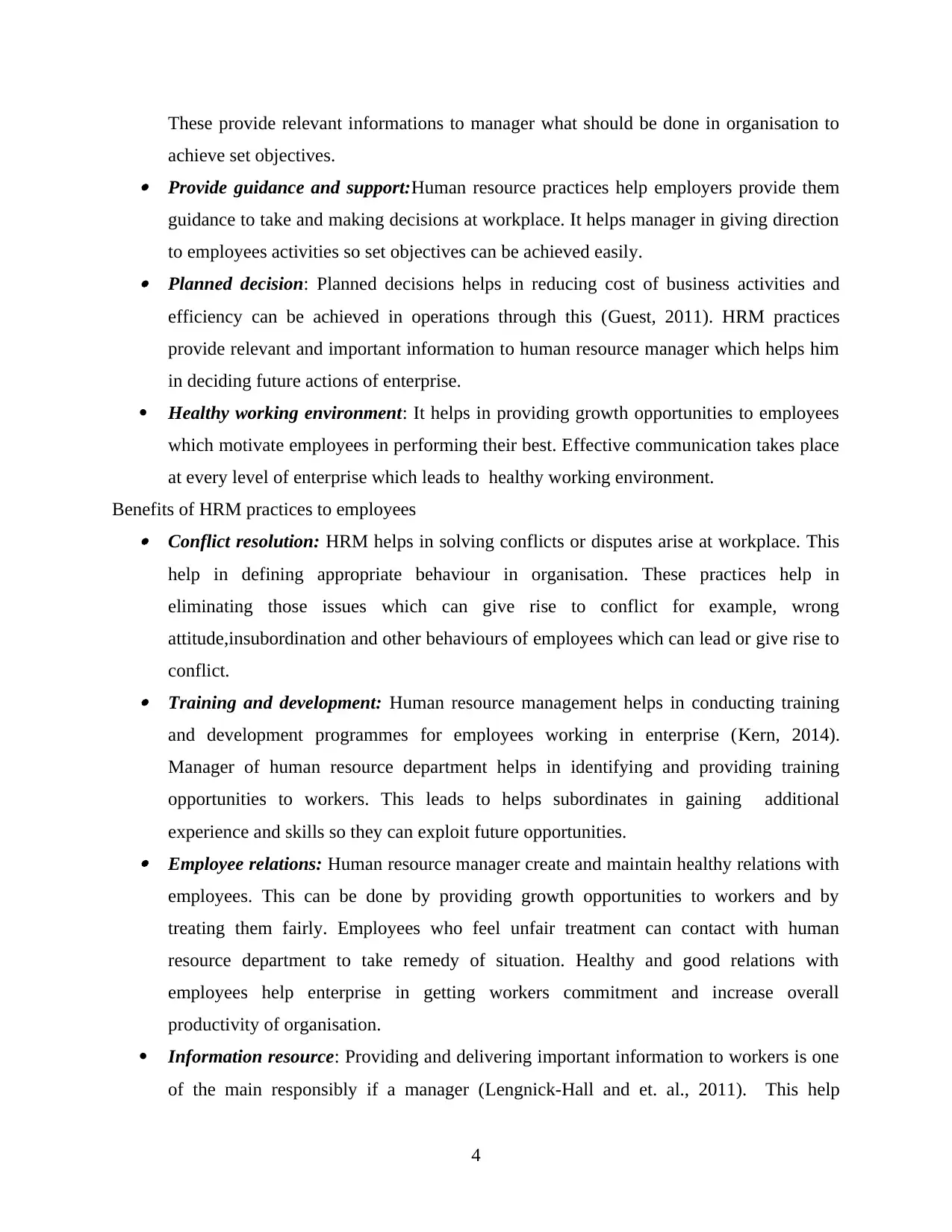
These provide relevant informations to manager what should be done in organisation to
achieve set objectives. Provide guidance and support:Human resource practices help employers provide them
guidance to take and making decisions at workplace. It helps manager in giving direction
to employees activities so set objectives can be achieved easily. Planned decision: Planned decisions helps in reducing cost of business activities and
efficiency can be achieved in operations through this (Guest, 2011). HRM practices
provide relevant and important information to human resource manager which helps him
in deciding future actions of enterprise.
Healthy working environment: It helps in providing growth opportunities to employees
which motivate employees in performing their best. Effective communication takes place
at every level of enterprise which leads to healthy working environment.
Benefits of HRM practices to employees Conflict resolution: HRM helps in solving conflicts or disputes arise at workplace. This
help in defining appropriate behaviour in organisation. These practices help in
eliminating those issues which can give rise to conflict for example, wrong
attitude,insubordination and other behaviours of employees which can lead or give rise to
conflict. Training and development: Human resource management helps in conducting training
and development programmes for employees working in enterprise (Kern, 2014).
Manager of human resource department helps in identifying and providing training
opportunities to workers. This leads to helps subordinates in gaining additional
experience and skills so they can exploit future opportunities. Employee relations: Human resource manager create and maintain healthy relations with
employees. This can be done by providing growth opportunities to workers and by
treating them fairly. Employees who feel unfair treatment can contact with human
resource department to take remedy of situation. Healthy and good relations with
employees help enterprise in getting workers commitment and increase overall
productivity of organisation.
Information resource: Providing and delivering important information to workers is one
of the main responsibly if a manager (Lengnick-Hall and et. al., 2011). This help
4
achieve set objectives. Provide guidance and support:Human resource practices help employers provide them
guidance to take and making decisions at workplace. It helps manager in giving direction
to employees activities so set objectives can be achieved easily. Planned decision: Planned decisions helps in reducing cost of business activities and
efficiency can be achieved in operations through this (Guest, 2011). HRM practices
provide relevant and important information to human resource manager which helps him
in deciding future actions of enterprise.
Healthy working environment: It helps in providing growth opportunities to employees
which motivate employees in performing their best. Effective communication takes place
at every level of enterprise which leads to healthy working environment.
Benefits of HRM practices to employees Conflict resolution: HRM helps in solving conflicts or disputes arise at workplace. This
help in defining appropriate behaviour in organisation. These practices help in
eliminating those issues which can give rise to conflict for example, wrong
attitude,insubordination and other behaviours of employees which can lead or give rise to
conflict. Training and development: Human resource management helps in conducting training
and development programmes for employees working in enterprise (Kern, 2014).
Manager of human resource department helps in identifying and providing training
opportunities to workers. This leads to helps subordinates in gaining additional
experience and skills so they can exploit future opportunities. Employee relations: Human resource manager create and maintain healthy relations with
employees. This can be done by providing growth opportunities to workers and by
treating them fairly. Employees who feel unfair treatment can contact with human
resource department to take remedy of situation. Healthy and good relations with
employees help enterprise in getting workers commitment and increase overall
productivity of organisation.
Information resource: Providing and delivering important information to workers is one
of the main responsibly if a manager (Lengnick-Hall and et. al., 2011). This help
4
⊘ This is a preview!⊘
Do you want full access?
Subscribe today to unlock all pages.

Trusted by 1+ million students worldwide
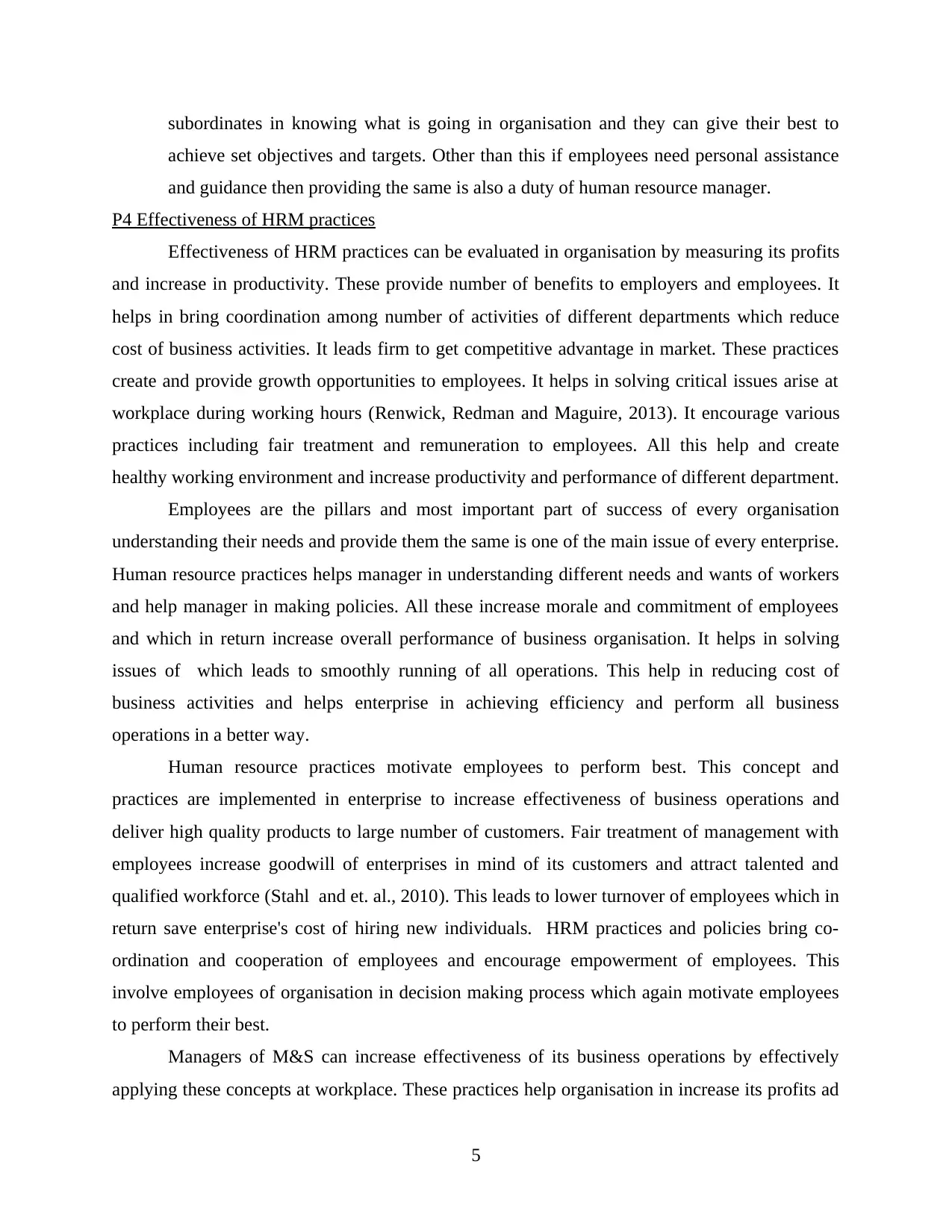
subordinates in knowing what is going in organisation and they can give their best to
achieve set objectives and targets. Other than this if employees need personal assistance
and guidance then providing the same is also a duty of human resource manager.
P4 Effectiveness of HRM practices
Effectiveness of HRM practices can be evaluated in organisation by measuring its profits
and increase in productivity. These provide number of benefits to employers and employees. It
helps in bring coordination among number of activities of different departments which reduce
cost of business activities. It leads firm to get competitive advantage in market. These practices
create and provide growth opportunities to employees. It helps in solving critical issues arise at
workplace during working hours (Renwick, Redman and Maguire, 2013). It encourage various
practices including fair treatment and remuneration to employees. All this help and create
healthy working environment and increase productivity and performance of different department.
Employees are the pillars and most important part of success of every organisation
understanding their needs and provide them the same is one of the main issue of every enterprise.
Human resource practices helps manager in understanding different needs and wants of workers
and help manager in making policies. All these increase morale and commitment of employees
and which in return increase overall performance of business organisation. It helps in solving
issues of which leads to smoothly running of all operations. This help in reducing cost of
business activities and helps enterprise in achieving efficiency and perform all business
operations in a better way.
Human resource practices motivate employees to perform best. This concept and
practices are implemented in enterprise to increase effectiveness of business operations and
deliver high quality products to large number of customers. Fair treatment of management with
employees increase goodwill of enterprises in mind of its customers and attract talented and
qualified workforce (Stahl and et. al., 2010). This leads to lower turnover of employees which in
return save enterprise's cost of hiring new individuals. HRM practices and policies bring co-
ordination and cooperation of employees and encourage empowerment of employees. This
involve employees of organisation in decision making process which again motivate employees
to perform their best.
Managers of M&S can increase effectiveness of its business operations by effectively
applying these concepts at workplace. These practices help organisation in increase its profits ad
5
achieve set objectives and targets. Other than this if employees need personal assistance
and guidance then providing the same is also a duty of human resource manager.
P4 Effectiveness of HRM practices
Effectiveness of HRM practices can be evaluated in organisation by measuring its profits
and increase in productivity. These provide number of benefits to employers and employees. It
helps in bring coordination among number of activities of different departments which reduce
cost of business activities. It leads firm to get competitive advantage in market. These practices
create and provide growth opportunities to employees. It helps in solving critical issues arise at
workplace during working hours (Renwick, Redman and Maguire, 2013). It encourage various
practices including fair treatment and remuneration to employees. All this help and create
healthy working environment and increase productivity and performance of different department.
Employees are the pillars and most important part of success of every organisation
understanding their needs and provide them the same is one of the main issue of every enterprise.
Human resource practices helps manager in understanding different needs and wants of workers
and help manager in making policies. All these increase morale and commitment of employees
and which in return increase overall performance of business organisation. It helps in solving
issues of which leads to smoothly running of all operations. This help in reducing cost of
business activities and helps enterprise in achieving efficiency and perform all business
operations in a better way.
Human resource practices motivate employees to perform best. This concept and
practices are implemented in enterprise to increase effectiveness of business operations and
deliver high quality products to large number of customers. Fair treatment of management with
employees increase goodwill of enterprises in mind of its customers and attract talented and
qualified workforce (Stahl and et. al., 2010). This leads to lower turnover of employees which in
return save enterprise's cost of hiring new individuals. HRM practices and policies bring co-
ordination and cooperation of employees and encourage empowerment of employees. This
involve employees of organisation in decision making process which again motivate employees
to perform their best.
Managers of M&S can increase effectiveness of its business operations by effectively
applying these concepts at workplace. These practices help organisation in increase its profits ad
5
Paraphrase This Document
Need a fresh take? Get an instant paraphrase of this document with our AI Paraphraser

productivity (Vörösmarty and et. al., 2010). Human resource manager take effective decision to
motivate employees and motivated workers give their best to enterprise which increase overall
profits and productivity of any firm. So to increase profits and productivity of enterprise it is
very important for manger to give attention to human resource practices. This not only motiba5te
employees but leads to decrease cost of all operations of workplace.
TASK 3
P5 Importance of employee relations in influencing HRM decision making
Healthy and good relations with employees is a sign of organisation success. To achieve
success or be successful in market it is very necessary for every organisation to make and
maintain healthy relations with customers (Wright and McMahan, 2011). Good relations with
workers increase their performance and make firm able to achieve its set targets and objectives.
There are number of ways through which healthy relations with subordinates can be maintain.
For this it is very important responsibility of employer or manager to provide enough
opportunities to workers for growth. Along with this fair treatment and fair remuneration should
be given to employees. Pay should be based on performance and concept of favouritism should
be eliminated from workplace.
From large number of workers the employees who perform well should be given
incentive and appraisal this will motivate him in performing well in enterprise. Fair remuneration
keeps employee morale high and help enterprise in getting their commitment. All these make
workers feel positive about the position they hole in firm and about their work. Confusions and
issues arise in mind of subordinates should be resolve by management. Positive work approach
at workplace should be adopted by firms (Cox, Arnold and Tomás, 2010). For this various stress
management techniques should be used by manager to to reduce stress of workers. Effective
redressal system should be there in firm to solve various issues of workers. Solutions of these
issues help enterprise in achieving consistency and smoothness in running of various activities.
Unhealthy relations with employees give birth to negative attitude at workplace.
Employee turnover will increase and productivity will decrease. This creates irritation in mind of
workers and cost of operations will rise. Managers of M&S should try to undertake various
activities and decision which help in creating and maintaining healthy relations with workers.
Following ways can be used by managers to create healthy relations with employees:
Fair remuneration and treatment should be done with every employee.
6
motivate employees and motivated workers give their best to enterprise which increase overall
profits and productivity of any firm. So to increase profits and productivity of enterprise it is
very important for manger to give attention to human resource practices. This not only motiba5te
employees but leads to decrease cost of all operations of workplace.
TASK 3
P5 Importance of employee relations in influencing HRM decision making
Healthy and good relations with employees is a sign of organisation success. To achieve
success or be successful in market it is very necessary for every organisation to make and
maintain healthy relations with customers (Wright and McMahan, 2011). Good relations with
workers increase their performance and make firm able to achieve its set targets and objectives.
There are number of ways through which healthy relations with subordinates can be maintain.
For this it is very important responsibility of employer or manager to provide enough
opportunities to workers for growth. Along with this fair treatment and fair remuneration should
be given to employees. Pay should be based on performance and concept of favouritism should
be eliminated from workplace.
From large number of workers the employees who perform well should be given
incentive and appraisal this will motivate him in performing well in enterprise. Fair remuneration
keeps employee morale high and help enterprise in getting their commitment. All these make
workers feel positive about the position they hole in firm and about their work. Confusions and
issues arise in mind of subordinates should be resolve by management. Positive work approach
at workplace should be adopted by firms (Cox, Arnold and Tomás, 2010). For this various stress
management techniques should be used by manager to to reduce stress of workers. Effective
redressal system should be there in firm to solve various issues of workers. Solutions of these
issues help enterprise in achieving consistency and smoothness in running of various activities.
Unhealthy relations with employees give birth to negative attitude at workplace.
Employee turnover will increase and productivity will decrease. This creates irritation in mind of
workers and cost of operations will rise. Managers of M&S should try to undertake various
activities and decision which help in creating and maintaining healthy relations with workers.
Following ways can be used by managers to create healthy relations with employees:
Fair remuneration and treatment should be done with every employee.
6
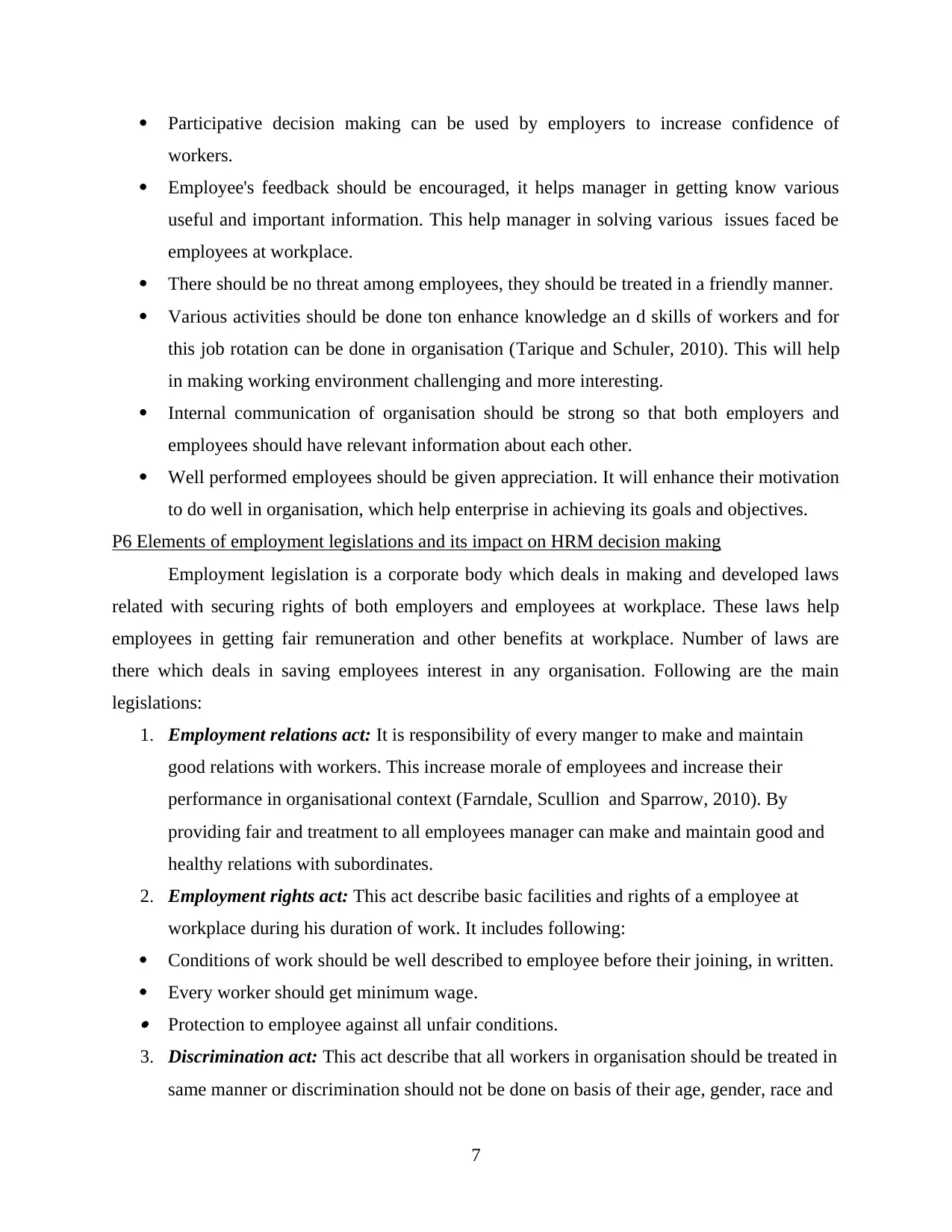
Participative decision making can be used by employers to increase confidence of
workers.
Employee's feedback should be encouraged, it helps manager in getting know various
useful and important information. This help manager in solving various issues faced be
employees at workplace.
There should be no threat among employees, they should be treated in a friendly manner.
Various activities should be done ton enhance knowledge an d skills of workers and for
this job rotation can be done in organisation (Tarique and Schuler, 2010). This will help
in making working environment challenging and more interesting.
Internal communication of organisation should be strong so that both employers and
employees should have relevant information about each other.
Well performed employees should be given appreciation. It will enhance their motivation
to do well in organisation, which help enterprise in achieving its goals and objectives.
P6 Elements of employment legislations and its impact on HRM decision making
Employment legislation is a corporate body which deals in making and developed laws
related with securing rights of both employers and employees at workplace. These laws help
employees in getting fair remuneration and other benefits at workplace. Number of laws are
there which deals in saving employees interest in any organisation. Following are the main
legislations:
1. Employment relations act: It is responsibility of every manger to make and maintain
good relations with workers. This increase morale of employees and increase their
performance in organisational context (Farndale, Scullion and Sparrow, 2010). By
providing fair and treatment to all employees manager can make and maintain good and
healthy relations with subordinates.
2. Employment rights act: This act describe basic facilities and rights of a employee at
workplace during his duration of work. It includes following:
Conditions of work should be well described to employee before their joining, in written.
Every worker should get minimum wage. Protection to employee against all unfair conditions.
3. Discrimination act: This act describe that all workers in organisation should be treated in
same manner or discrimination should not be done on basis of their age, gender, race and
7
workers.
Employee's feedback should be encouraged, it helps manager in getting know various
useful and important information. This help manager in solving various issues faced be
employees at workplace.
There should be no threat among employees, they should be treated in a friendly manner.
Various activities should be done ton enhance knowledge an d skills of workers and for
this job rotation can be done in organisation (Tarique and Schuler, 2010). This will help
in making working environment challenging and more interesting.
Internal communication of organisation should be strong so that both employers and
employees should have relevant information about each other.
Well performed employees should be given appreciation. It will enhance their motivation
to do well in organisation, which help enterprise in achieving its goals and objectives.
P6 Elements of employment legislations and its impact on HRM decision making
Employment legislation is a corporate body which deals in making and developed laws
related with securing rights of both employers and employees at workplace. These laws help
employees in getting fair remuneration and other benefits at workplace. Number of laws are
there which deals in saving employees interest in any organisation. Following are the main
legislations:
1. Employment relations act: It is responsibility of every manger to make and maintain
good relations with workers. This increase morale of employees and increase their
performance in organisational context (Farndale, Scullion and Sparrow, 2010). By
providing fair and treatment to all employees manager can make and maintain good and
healthy relations with subordinates.
2. Employment rights act: This act describe basic facilities and rights of a employee at
workplace during his duration of work. It includes following:
Conditions of work should be well described to employee before their joining, in written.
Every worker should get minimum wage. Protection to employee against all unfair conditions.
3. Discrimination act: This act describe that all workers in organisation should be treated in
same manner or discrimination should not be done on basis of their age, gender, race and
7
⊘ This is a preview!⊘
Do you want full access?
Subscribe today to unlock all pages.

Trusted by 1+ million students worldwide
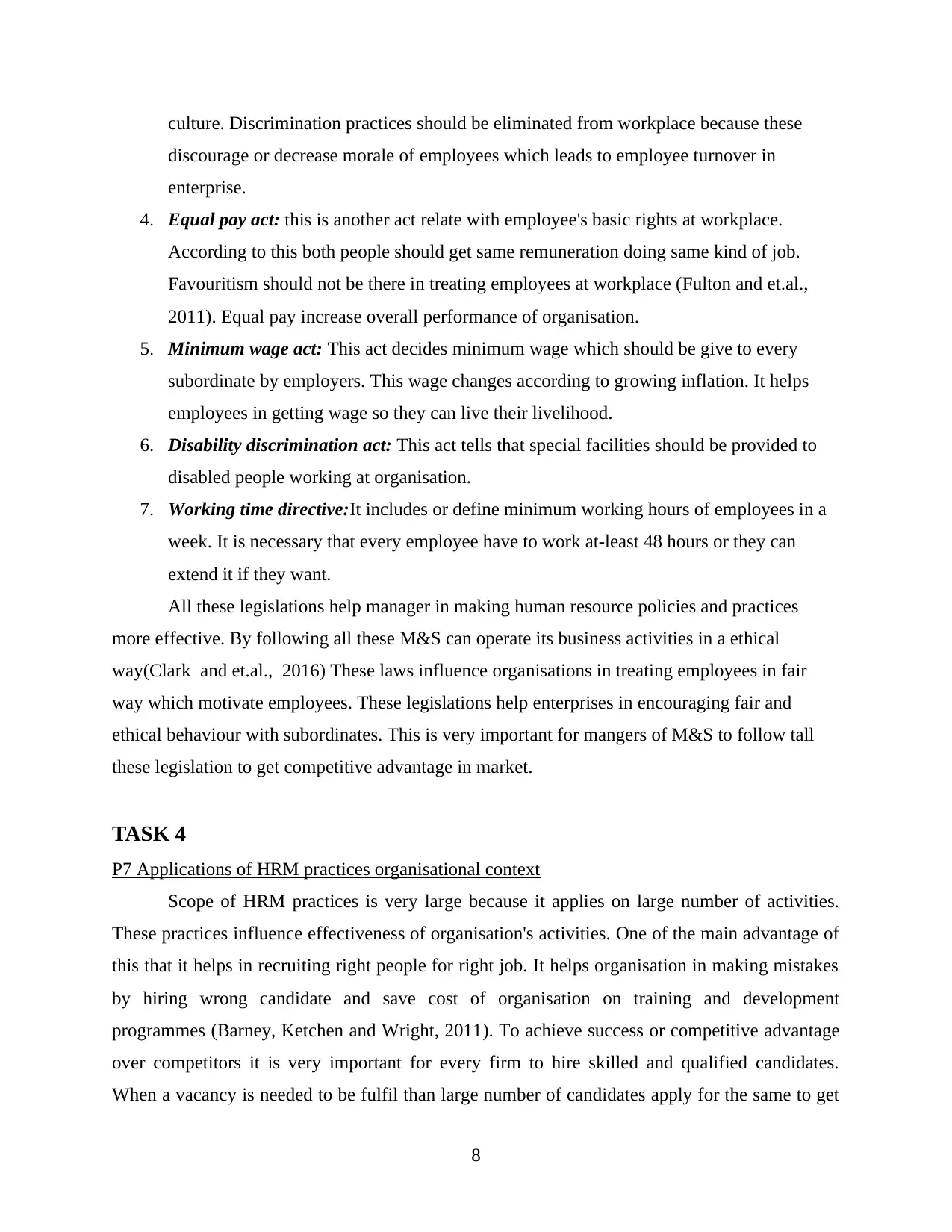
culture. Discrimination practices should be eliminated from workplace because these
discourage or decrease morale of employees which leads to employee turnover in
enterprise.
4. Equal pay act: this is another act relate with employee's basic rights at workplace.
According to this both people should get same remuneration doing same kind of job.
Favouritism should not be there in treating employees at workplace (Fulton and et.al.,
2011). Equal pay increase overall performance of organisation.
5. Minimum wage act: This act decides minimum wage which should be give to every
subordinate by employers. This wage changes according to growing inflation. It helps
employees in getting wage so they can live their livelihood.
6. Disability discrimination act: This act tells that special facilities should be provided to
disabled people working at organisation.
7. Working time directive:It includes or define minimum working hours of employees in a
week. It is necessary that every employee have to work at-least 48 hours or they can
extend it if they want.
All these legislations help manager in making human resource policies and practices
more effective. By following all these M&S can operate its business activities in a ethical
way(Clark and et.al., 2016) These laws influence organisations in treating employees in fair
way which motivate employees. These legislations help enterprises in encouraging fair and
ethical behaviour with subordinates. This is very important for mangers of M&S to follow tall
these legislation to get competitive advantage in market.
TASK 4
P7 Applications of HRM practices organisational context
Scope of HRM practices is very large because it applies on large number of activities.
These practices influence effectiveness of organisation's activities. One of the main advantage of
this that it helps in recruiting right people for right job. It helps organisation in making mistakes
by hiring wrong candidate and save cost of organisation on training and development
programmes (Barney, Ketchen and Wright, 2011). To achieve success or competitive advantage
over competitors it is very important for every firm to hire skilled and qualified candidates.
When a vacancy is needed to be fulfil than large number of candidates apply for the same to get
8
discourage or decrease morale of employees which leads to employee turnover in
enterprise.
4. Equal pay act: this is another act relate with employee's basic rights at workplace.
According to this both people should get same remuneration doing same kind of job.
Favouritism should not be there in treating employees at workplace (Fulton and et.al.,
2011). Equal pay increase overall performance of organisation.
5. Minimum wage act: This act decides minimum wage which should be give to every
subordinate by employers. This wage changes according to growing inflation. It helps
employees in getting wage so they can live their livelihood.
6. Disability discrimination act: This act tells that special facilities should be provided to
disabled people working at organisation.
7. Working time directive:It includes or define minimum working hours of employees in a
week. It is necessary that every employee have to work at-least 48 hours or they can
extend it if they want.
All these legislations help manager in making human resource policies and practices
more effective. By following all these M&S can operate its business activities in a ethical
way(Clark and et.al., 2016) These laws influence organisations in treating employees in fair
way which motivate employees. These legislations help enterprises in encouraging fair and
ethical behaviour with subordinates. This is very important for mangers of M&S to follow tall
these legislation to get competitive advantage in market.
TASK 4
P7 Applications of HRM practices organisational context
Scope of HRM practices is very large because it applies on large number of activities.
These practices influence effectiveness of organisation's activities. One of the main advantage of
this that it helps in recruiting right people for right job. It helps organisation in making mistakes
by hiring wrong candidate and save cost of organisation on training and development
programmes (Barney, Ketchen and Wright, 2011). To achieve success or competitive advantage
over competitors it is very important for every firm to hire skilled and qualified candidates.
When a vacancy is needed to be fulfil than large number of candidates apply for the same to get
8
Paraphrase This Document
Need a fresh take? Get an instant paraphrase of this document with our AI Paraphraser
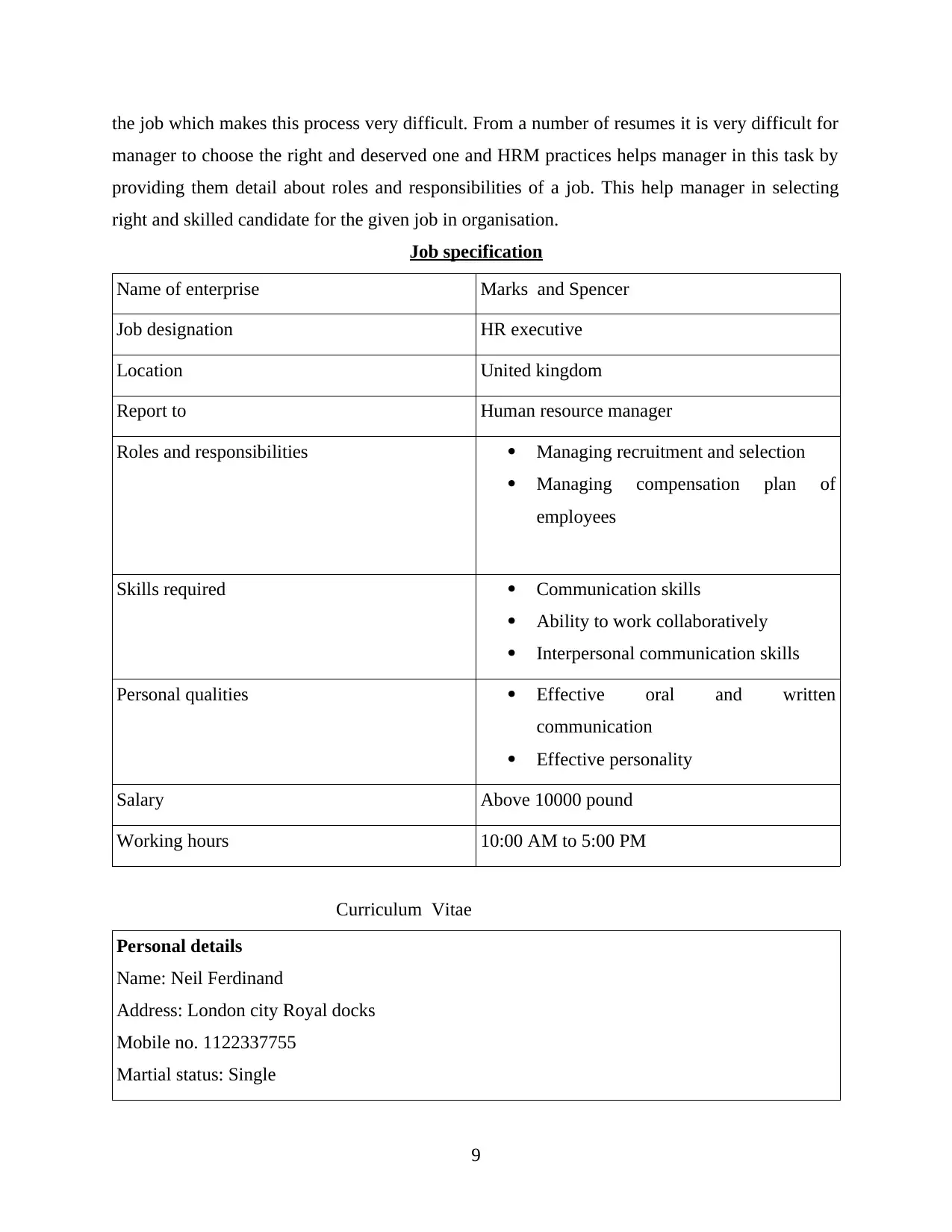
the job which makes this process very difficult. From a number of resumes it is very difficult for
manager to choose the right and deserved one and HRM practices helps manager in this task by
providing them detail about roles and responsibilities of a job. This help manager in selecting
right and skilled candidate for the given job in organisation.
Job specification
Name of enterprise Marks and Spencer
Job designation HR executive
Location United kingdom
Report to Human resource manager
Roles and responsibilities Managing recruitment and selection
Managing compensation plan of
employees
Skills required Communication skills
Ability to work collaboratively
Interpersonal communication skills
Personal qualities Effective oral and written
communication
Effective personality
Salary Above 10000 pound
Working hours 10:00 AM to 5:00 PM
Curriculum Vitae
Personal details
Name: Neil Ferdinand
Address: London city Royal docks
Mobile no. 1122337755
Martial status: Single
9
manager to choose the right and deserved one and HRM practices helps manager in this task by
providing them detail about roles and responsibilities of a job. This help manager in selecting
right and skilled candidate for the given job in organisation.
Job specification
Name of enterprise Marks and Spencer
Job designation HR executive
Location United kingdom
Report to Human resource manager
Roles and responsibilities Managing recruitment and selection
Managing compensation plan of
employees
Skills required Communication skills
Ability to work collaboratively
Interpersonal communication skills
Personal qualities Effective oral and written
communication
Effective personality
Salary Above 10000 pound
Working hours 10:00 AM to 5:00 PM
Curriculum Vitae
Personal details
Name: Neil Ferdinand
Address: London city Royal docks
Mobile no. 1122337755
Martial status: Single
9
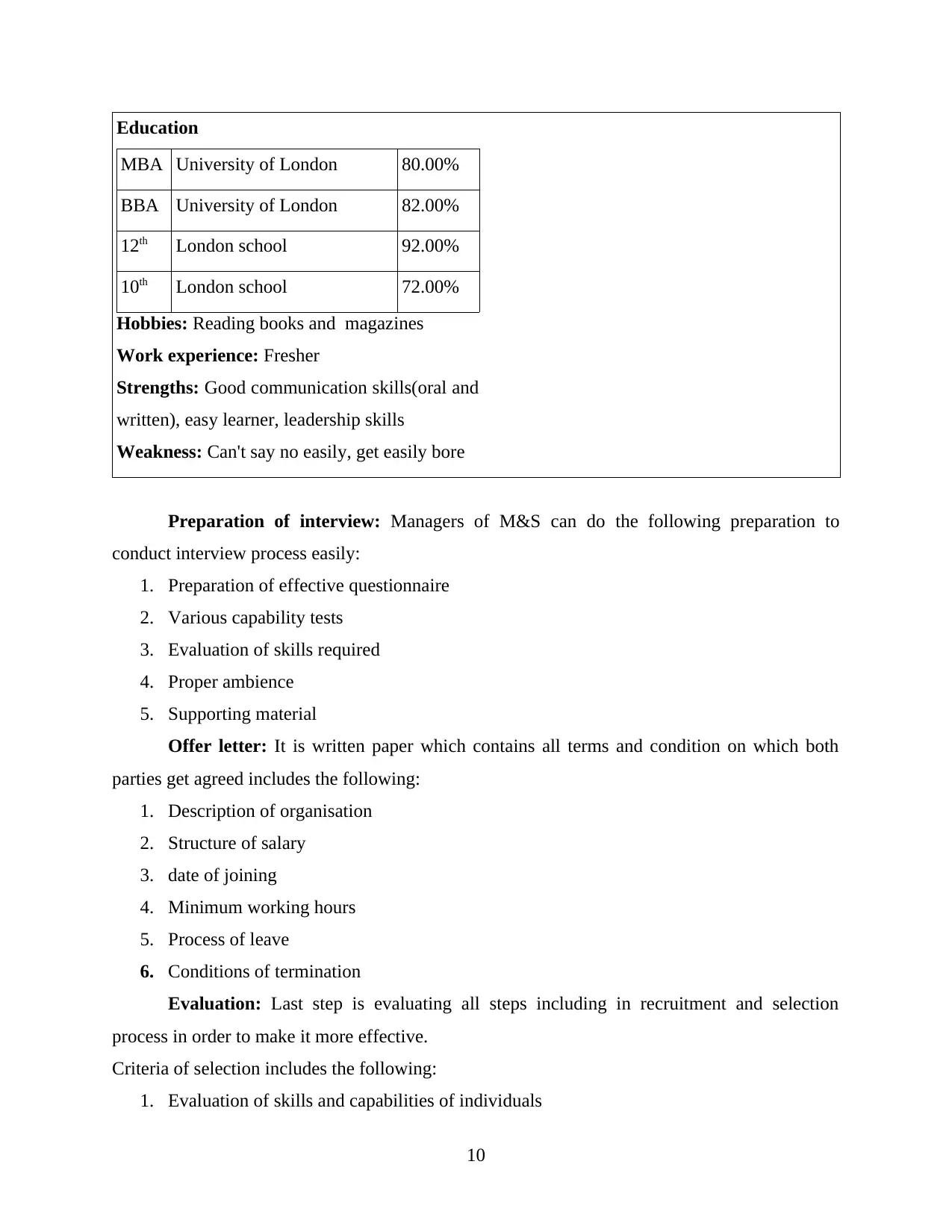
Education
MBA University of London 80.00%
BBA University of London 82.00%
12th London school 92.00%
10th London school 72.00%
Hobbies: Reading books and magazines
Work experience: Fresher
Strengths: Good communication skills(oral and
written), easy learner, leadership skills
Weakness: Can't say no easily, get easily bore
Preparation of interview: Managers of M&S can do the following preparation to
conduct interview process easily:
1. Preparation of effective questionnaire
2. Various capability tests
3. Evaluation of skills required
4. Proper ambience
5. Supporting material
Offer letter: It is written paper which contains all terms and condition on which both
parties get agreed includes the following:
1. Description of organisation
2. Structure of salary
3. date of joining
4. Minimum working hours
5. Process of leave
6. Conditions of termination
Evaluation: Last step is evaluating all steps including in recruitment and selection
process in order to make it more effective.
Criteria of selection includes the following:
1. Evaluation of skills and capabilities of individuals
10
MBA University of London 80.00%
BBA University of London 82.00%
12th London school 92.00%
10th London school 72.00%
Hobbies: Reading books and magazines
Work experience: Fresher
Strengths: Good communication skills(oral and
written), easy learner, leadership skills
Weakness: Can't say no easily, get easily bore
Preparation of interview: Managers of M&S can do the following preparation to
conduct interview process easily:
1. Preparation of effective questionnaire
2. Various capability tests
3. Evaluation of skills required
4. Proper ambience
5. Supporting material
Offer letter: It is written paper which contains all terms and condition on which both
parties get agreed includes the following:
1. Description of organisation
2. Structure of salary
3. date of joining
4. Minimum working hours
5. Process of leave
6. Conditions of termination
Evaluation: Last step is evaluating all steps including in recruitment and selection
process in order to make it more effective.
Criteria of selection includes the following:
1. Evaluation of skills and capabilities of individuals
10
⊘ This is a preview!⊘
Do you want full access?
Subscribe today to unlock all pages.

Trusted by 1+ million students worldwide
1 out of 15
Related Documents
Your All-in-One AI-Powered Toolkit for Academic Success.
+13062052269
info@desklib.com
Available 24*7 on WhatsApp / Email
![[object Object]](/_next/static/media/star-bottom.7253800d.svg)
Unlock your academic potential
Copyright © 2020–2025 A2Z Services. All Rights Reserved. Developed and managed by ZUCOL.





